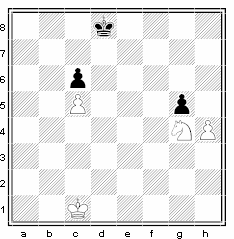Capture the Scepter
The idea behind this game was suggested by many before in several variants, but had not reached fruition because of fundamentally flawed assumptions that were made regarding the drawing nature of chess .Setup
As in orthodox chess, or the particular variant you are trying to use with these new rules.Pieces
The pieces move exactly as in orthodox chess except for:The Extra-mobile sliding pawn
Normally, when a pawn faces an opposing pawn or an enemy piece, the pawn is blocked. However, the sliding pawn can, under these circumstances only if it is blocked, slide pass the enemy piece or pawn with the same 1-step diagonal movement that it would make when capturing.

|
Sliding Pawn movement
If it is white's turn to move: The pawn at c5 can slide past c6 by going to either d6 or b6. If it is black's turn to move, the pawn on c6 can slide to b5 or d5. Also the pawn at g5 can either capture the pawn at h4 (as usual) OR it can also slide past the white knight by moving to f4! |
Rules
The rules are exactly as in orthodox chess except for the sliding pawn and the following:The Scepter
This is a magic wand, possessed by both sides, which must be protected at all cost, for losing it to the opposing king loses the throne, the kingdom … everything. So in addition to checkmate - the surrender to the enemy - this is an additional objective in the game, but only a king can capture a scepter.The scepter is normally kept on the king's original square on e1 or e8. In some variations, Omega Chess, for instance, it can be kept on the king's wizard's square or in other variations, it might be kept on two or even three squares. No matter how many squares it is kept on, the objective is for the king to capture the opposing king's scepter.
The scepter is never moved, and even if the king castles, the scepter remains on the same square.Stalemate where the opponent's king, even though surrounded, has tricked your forces and avoided checkmate
(visualize as a secret getaway or committing suicide), is still a draw.
A 3-time repetition of position that results from nether side unable to gain ground by engaging each other, is also a draw.
Notes
It is established that the capture the scepter component is strategically rich and can be used, not just with orthodox chess, but also in other chess variants. Games like Asylum Chess and Omega chess can all employ this idea. In Asylum Chess, the scepter will be at f1 and f10, but in Omega Chess, the scepter will be at the king's wizard squares, w2 and w3, (this seems best). In other variants, it can be on more than 1 square.
Similarly, the sliding pawns can be used as a feature in many different types of variants, especially variants that are not very chess-like i.e. dissimilar to standard chess. The author, being a bit cautious, will not suggest that the sliding pawns be used for chess-like variants simply because they change the nature of the game completely! However, other variant inventors are welcome to use the sliding pawns in their variants if they desire a more dynamic sort of pawn.
In the meantime why not play a totally different game of chess with mobile pawns and the kings’ scepters - Capture the Scepter! This 'user submitted' page is a collaboration between the posting user and the Chess Variant Pages. Registered contributors to the Chess Variant Pages have the ability to post their own works, subject to review and editing by the Chess Variant Pages Editorial Staff.
This 'user submitted' page is a collaboration between the posting user and the Chess Variant Pages. Registered contributors to the Chess Variant Pages have the ability to post their own works, subject to review and editing by the Chess Variant Pages Editorial Staff.
By Charles Daniel.
Last revised by H. G. Muller.
Web page created: 2007-09-11. Web page last updated: 2022-11-30
